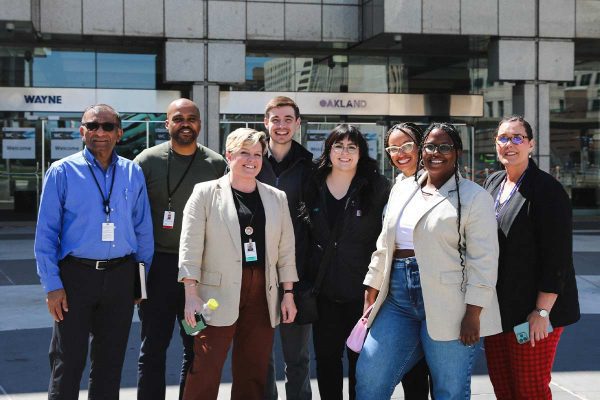The ASAE Convene Green Alliance (CGA) hosted a “Sustainability Smackdown: Mythbusting for Green Meeting Skeptics and Procrastinators” at the May 15 ASAE Springtime Expo at the Walter E. Washington Convention Center in Washington, DC.

Green meetings have been popular for years, but a few people still seem to need convincing that sustainability is smart business.
Seeded with heckling actors, the session tackled five common myths about green meetings and – led by CGA Director Kristin Clarke – featured “mythbusters” Bridget Chisholm, conference director of the International Leadership Association, and Cheryl Wallen, meeting planner for the Association of Zoos & Aquariums.
The speakers shared a gavel and compelling arguments to show how any organization can take advantage of green meeting practices to generate valuable ROI.
“Created in a funky format, this fun session sought to kill outdated green meeting assumptions related to areas such as budgeting, workloads, actual impact analysis and attendee attitudes,” Clarke said. “I still hear such excuses used by meeting planners who are new to the industry or who have not kept up enough in their professional field to realize that sustainability is no longer a trend, but a constant”
Myth No. 1: Green meetings cost more.
“What are we concerned about?” Chisholm asked “What costs so much? If it was 1984, maybe cost would be a deal breaker. But it’s 2014! It doesn’t cost any more to use a LEED-certified facility or sustainable lanyards.
“And what is more expensive about serving locally crafted beer or wine? Even tomatoes grown locally cost the same or are cheaper and often are much better-tasting than tomatoes grown elsewhere. Also, tote bags with recycled content might have cost more 10 years ago, but not today. People always assume there is a green premium, but that’s generally not true anymore. You need to ask.”
Clarke, who shared results of a 2013 CGA survey on association involvement in green meetings, also suggested looking at the total bottom line rather than line-by-line. She noted adjustments can be made to even out expenses, such as offsetting slightly higher prices for organic food against cost savings of, say, switching from plastic water bottles to water stations or sponsored reusable bottles.
Another tip she mentioned is to work with the food and beverage department well in advance of a meeting to leverage strong relationships between the chef and local farmers and negotiate better food pricing, identify what’s in season and is therefore cheaper, and ensure access to sustainable ingredients.
Myth No. 2: Green meetings are a hassle because sustainability decisions add to my workload.
Wallen and other meeting planners have found that working with local partners can save time and easily tap local expertise on such issues as recycling or composting regulations and community service opportunities while offering solutions that will be popular with members who increasingly expect or ask for sustainable events.
“The hospitality community of hotels, convention centers and other vendors that support meetings already has taken much of the work and expense out of greening conferences by pioneering innovations and boosting access to eco-friendly operations and opportunities,” Wallen said. “Increasingly, they get it – and so do associations.
“It’s a learning curve for everyone, but those on the ground are usually very knowledgeable and eager to help.”
Myth No. 3: My attendees/vendors/exhibitors don’t care about green meetings.
Wallen busted this myth by noting, “My members don’t give me a choice about green meetings. When you have ‘wild places’ in your mission statement, you have to pay attention to the environment.”
She cited studies that show people do care – with 75 percent of the public recycling, that means attendees are recycling at home and/or at the office.
“Why would your conference be any different?” Wallen asked. “Our members will hold onto a piece of paper until they find a recycling bin to put it in. It’s also just the right thing to do. Surveys of the impact of waste on the environment demonstrate that. We have a green mission logo next to everything we do that is green.”
According to the CGA survey, 64 percent of CGA members and ASAE meeting professionals reported that sustainability is fairly to critically important to their booking decisions, so these leaders clearly do care that they reflect the public’s greener attitudes and obtain the maximum ROI from doing so.
Myth No. 4: Our meetings are small, so we can’t make an impact with green meetings.
“You don’t think you are able to create change when you are small, but those collective asks across the country are making a difference,” Chisholm said. “How did LEED certification get started? People asked for it. Even small meetings can boost the local economy and the livelihoods of local farmers.”
“Small meetings are the fastest-growing segment of the meetings industry,” Clarke added. “The impact when you add them all together becomes quite formidable.”
Myth No 5: I don’t know much about green meetings.
“Talk to your convention and visitors’ center, convention center, hotel and other local partners – they have plenty of information,” said Chisholm. “And you’ll find plenty of online resources.”
“You don’t have to go by any particular standards to green your meeting,” said Clarke. “But they can be helpful to use as simple checklists or goal-setting tools.”
Getting Started
Besides myth-busting, speakers also offered practical advice on getting started with green meetings.
“You don’t have to do everything,” said Clarke. “Once you take your first green meeting action and hopefully track what you are doing and its impact, it becomes easier for future meetings.
“Holding paper-free and paper-lite meetings are good first steps. The fear that people will object to this has generally not materialized. People are more digitally oriented and are more comfortable using meeting apps.
“Running a recycling program is also an easy thing to do. People are used to this and will appreciate having it.”
Holding meetings in facilities committed to sustainable meetings also is critical to making green meetings easy, creative and cost-effective.
“Choosing a sustainable venue is the top thing that planners want to do,” Clarke said. “Convene Green is always urging planners to ask about sustainability on their RFPs, something that about 85 percent of CGA members report doing.”
For more information on CGA, visit www.convenegreen.com.





























